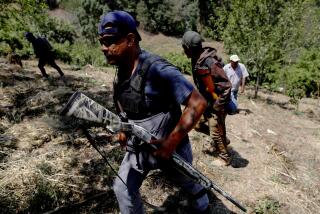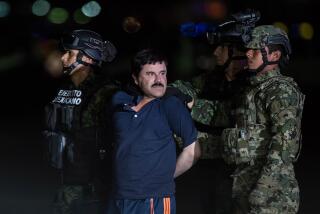U.S. Embassy in Mexico not told of ATF guns sting
Reporting from Washington — As weapons from the United States increasingly began showing up at homicide scenes in Mexico last summer, U.S. Embassy officials cabled Washington that authorities needed to focus on small-time operators supplying guns to the drug cartels.
Embassy officials did not know that at least some of the weapons were part of an ill-fated sting run by the Bureau of Alcohol, Tobacco, Firearms and Explosives, in which illegal straw purchasers were allowed to buy guns so smuggling routes into Mexico could be traced. Ultimately, ATF lost track of an estimated 1,700 weapons that were part of the so-called Fast and Furious operation, which began in November 2009.
Nearly 200 such guns were later recovered at crime scenes in Mexico. And two AK-47s from Fast and Furious were recovered in December at the scene of the fatal shooting of a U.S. Border Patrol agent in Arizona.
The embassy cable, written in July 2010, is further evidence that ATF officials were keeping information about Fast and Furious from other branches of government, even after the operation lost track of some guns. The six-page document, labeled “Sensitive But Unclassified,” was obtained by The Times’ Washington bureau.
“This was a shout-out from the embassy in Mexico,” said a government official close to the investigation of the program. “The embassy knew something was awry when all these guns started showing up down there. But they were kept in the dark. They didn’t understand why the guns kept getting through and ending up at so many Mexican homicides.”
The official spoke on condition of anonymity because he was not authorized to discuss the investigation publicly.
At ATF and Justice Department headquarters, officials declined to discuss specifics about Fast and Furious, citing ongoing investigations.
The cable was sent to the State Department in Washington and copied to about 50 officials, including then-U.S. Ambassador Carlos Pascual; Darren Gil, then the ATF attache in Mexico City; and his deputy, Carlos Canino.
Gil and Canino are quoted in a separate report released Monday night by the House Committee on Oversight and Government Reform, chaired by Rep. Darrell Issa (R-Vista). He and Sen. Charles E. Grassley (R-Iowa) of the Senate Judiciary Committee are investigating Fast and Furious.
Gil and Canino testified that the embassy was “kept in the dark” about the program even as the Mexican government was complaining about so many U.S. guns in the country.
Gil said when he first queried ATF officials in Phoenix, where the program was run, they told him the bare minimum. According to Gil, George Gillett Jr., then the acting special agent in charge, said, “We have an ongoing investigation…. Thanks for calling.”
He also questioned ATF headquarters in Washington, Gil said, and was told, “They have it under control.”
As he learned what had gone wrong, Gil said, he realized that ATF officials did not want Pascual to know about the operation, and that ATF feared the Mexican government would find out and lodge a formal complaint.
Gil recalled “screaming and yelling” with his Washington superiors. “It’s inconceivable to me to even allow weapons to knowingly cross an international border,” he said.
Gil and Canino said they later were advised that senior ATF leaders, including acting Director Kenneth Melson, as well as Department of Justice officials and the U.S. attorney’s office in Phoenix, all had approved Fast and Furious. Melson said it was “providing some good intelligence” on gun smuggling.
The embassy cable also indicates that U.S. officials with considerable knowledge of the drug trade and violence in Mexico disagreed with the premise on which Fast and Furious was based.
The ATF believed that large cartels were smuggling the weapons across the border, but embassy officials viewed that as a myth. Although the cartels “are the largest consumer of illegal firearms in Mexico,” the cable says, “they are not the primary trafficking agents of weapons going south from the United States.”
The cable advises ATF to concentrate on arresting individual Mexican traffickers living legally in the U.S.
The cable also discounts ATF’s assertion that the Rio Grande had become a virtual “Iron River” of guns, with the cartels taking over gun smuggling. “Rather,” the memo says, “it appears there may be thousands of small streams.”
More to Read
Sign up for Essential California
The most important California stories and recommendations in your inbox every morning.
You may occasionally receive promotional content from the Los Angeles Times.











